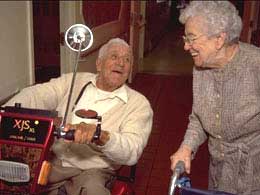Completion requirements
View
Topic Overview

- Family caregivers are an integral part of the health care system.
- Transitions of care from one setting to another can be a challenging time for older adults.
- Knowing about the resources available to your family member and you helps to determine when and where to ask for help.
- It is often necessary to accept help in order to stay in the community.
- There are various types and levels of care available for older adults.
Introduction

- As people grow older, they often struggle to achieve a balance between maintaining independence and accepting help.
- Most older adults would like to live at home for as long as they can.
- As a caregiver, you may find that you are overwhelmed and exhausted with providing care to your family member.
- Caregivers require support to ensure they can continue to provide care and maintain their own well being.
- Caregivers should expect support based on respect, right to choose and self-determination.
What You Need to Know
Support for Older Adults Living in the Community

- Caregivers are often overwhelmed by many stressors such as time pressures, financial concerns and childcare issues.
- The first step in seeking help involves acceptance. Acceptance consists of recognizing that your family member and you are facing a challenge and agree to get help.
- Challenges in day-to-day routines can include personal care like bathing, or more difficult tasks like transportation, grocery shopping, managing money, and house maintenance.
- As a caregiver, if you start to feel exhausted and overwhelmed, it is important to recognize that there are supports available for your family member.
- Community supports are available that allow older adults to maximize their potential and function in their home environment for as long as possible.
- Community supports include Home Care, day programs, and numerous community agencies that can help with transportation, yard work, meal delivery, and housework.
Levels of Care
- When your family member can no longer manage living in their own home, different levels of care are available, based on the type and amount of care needed. It is important that your family member is fully involved in the decision to move. It is never too early to discuss alternative types of housing and to begin planning for the future.
- In Alberta, Alberta Health Services continuing care system provides various types and levels of care for older adults that support their independence and quality of life.
- There are three settings in which continuing care system provides accommodation, health care and personal services:
- Home Living
- Supportive Living
- Facility Living
Home Living

- Home Living services provide homecare for older adults who live in their own home, apartment, or another independent setting.
- Home Living can provide in-home professional support services such as nursing and rehabilitation, personal support services and equipment.
- Examples of personal support services include medication, bathing or grooming assistance.
- Home care services are publically funded and provided through Alberta Health Services.
Supportive Living
- Supportive Living combines accommodation services with other supports and care.
- Supportive living settings vary by size and types of services provided. It can include meals, housekeeping and social activities.
- Residents pay a fee to cover the cost of accommodation and such services.
- Residents can also receive professional and personal support services through Home Living (Home care).
- These can be operated by private for profit, private non-profit, and public operators.
- Examples include: seniors lodges, group/personal care homes, private supportive living and Designated Supportive Living.
- Designated supportive living are settings that have a contract with AHS for additional health and personal care services.
Facility Living
- Facility living includes long-term care facilities like nursing homes and auxiliary hospitals.
- Care and accommodation services are provided for people with complex health needs who are unable to remain at home or in a supportive living setting.
- Residents pay an accommodation fee to cover the costs of providing accommodations and services like meals, housekeeping and building maintenance.
- Health services in long-term care are publicly-funded and provided through Alberta Health Services.
- You and your family member cannot access these options directly. Alternative levels of care within the health authorities are accessed through Community Care Access.
See Also
While the content of each Caregiver College Topic may be linked to a variety of other Topic areas, the following have been identified as a Key Linkage which you may be interested in also reviewing:
Resources
Alberta Health Services
- Health Link: Health Link Alberta is a 24 hours a day, seven days a week telephone health advice and health information service answered by registered nurses that anyone in Alberta can access.
- Long-Term Care provides a brief overview of intermediate and chronic care programs for qualified veterans and certain civilians.
- Veterans Independence Program helps qualified veterans and certain civilians to remain healthy and independent in their own homes and communities.
- Housing for Seniors: For nearly 50 years GEF has been providing seniors with quality affordable housing and supportive living services at residences located throughout the City of Edmonton.
The Seniors Association of Greater Edmonton
- Seniors Housing Guide is an excellent housing resource for older adults which includes comprehensive information about housing available to older adults of Edmonton and area. The Seniors Housing Guide is a free publication and can be picked up at SAGE as well as many senior serving agencies in the city or downloaded from this website.
Last modified: Wednesday, April 27, 2022, 9:32 AM